Edge Computing: Performance Assessment in the Hybrid Prediction Method on a Low-Cost Raspberry Pi Platform
Abstract
1. Introduction
2. Related Works, Concepts and Architecture
2.1. Conceptual Foundations and Related Works
2.2. Evaluated Solution Architecture
- Explicit Extraction of Visual Features: application of image processing algorithms on each captured image, resulting in nine (9) visual features (set f of measures). These features are detailed in the next section;
- Prediction via ML Models: use of ML models previously trained to estimate solar irradiance over short-term horizons, based on the historical set f of measures captured by the HPM. For this purpose, the HPM originally employs a ML algorithm based on an Artificial Neural Network (ANN) with a MultiLayer Perceptron architecture, which is then used as a comparative baseline.
2.3. HPM Features Description
2.4. Raspberry Pi 4 Model B
3. Materials and Method
3.1. Experimental Design
3.2. Tools and Technologies
4. Results and Discussion
4.1. Computer Processing Performance
4.2. Resolutions and Associated Errors
4.3. Hypothesis Verification
5. Conclusions
Author Contributions
Funding
Institutional Review Board Statement
Informed Consent Statement
Data Availability Statement
Acknowledgments
Conflicts of Interest
References
- International Energy Agency. Global Energy Review 2025; IEA: Paris, France, 2025; p. 43. [Google Scholar]
- Li, Y.; Wang, R.; Li, Y.; Zhang, M.; Long, C. Wind Power Forecasting Considering Data Privacy Protection: A Federated Deep Reinforcement Learning Approach. Appl. Energy 2023, 329, 120291. [Google Scholar] [CrossRef]
- ABSOLAR. Brasil Ultrapassa Marca de 42 GW de Potência Instalada; Associação Brasileira de Energia Solar: São Paulo, Brazil, 2024. [Google Scholar]
- ANEEL. Sistema de Informações de Geração da ANEEL—SIGA. Available online: https://bit.ly/2IGf4Q0 (accessed on 20 July 2022).
- ABSOLAR. Energia Solar Fotovoltaica No Brasil—Infográfico ABSOLAR. Available online: https://www.absolar.org.br/mercado/infografico (accessed on 20 July 2022).
- Da Rosa, A.R.O.; Gasparin, F.P. Panorama da Energia Solar Fotovoltaica no Brasil. Rev. Bras. Energ. Sol. 2016, 7, 140–147. [Google Scholar]
- Rezende, J.O. (Ed.) A Importância Da Energia Solar Para o Desenvolvimento Sustentável; Atena Editora: Ponta Grossa, Brazil, 2019; ISBN 978-85-7247-616-4. [Google Scholar]
- Antonanzas, J.; Osorio, N.; Escobar, R.; Urraca, R.; Martinez-de-Pison, F.J.; Antonanzas-Torres, F. Review of Photovoltaic Power Forecasting. Sol. Energy 2016, 136, 78–111. [Google Scholar] [CrossRef]
- Maciel, J.N.; Ledesma, J.J.G.; Ando Junior, O.H. Forecasting Solar Power Output Generation: A Systematic Review with the Proknow-C. IEEE Lat. Am. Trans. 2021, 19, 612–624. [Google Scholar] [CrossRef]
- Ying, C.; Wang, W.; Yu, J.; Li, Q.; Yu, D.; Liu, J. Deep Learning for Renewable Energy Forecasting: A Taxonomy, and Systematic Literature Review. J. Clean. Prod. 2023, 384, 135414. [Google Scholar] [CrossRef]
- Das, U.K.; Tey, K.S.; Seyedmahmoudian, M.; Mekhilef, S.; Idris, M.Y.I.; Van Deventer, W.; Horan, B.; Stojcevski, A. Forecasting of Photovoltaic Power Generation and Model Optimization: A Review. Renew. Sustain. Energy Rev. 2018, 81, 912–928. [Google Scholar] [CrossRef]
- Du, P.; Lu, N. Energy Storage for Smart Grids: Planning and Operation for Renewable and Variable Energy Resources (VERs); Elsevier: Amsterdam, The Netherlands, 2014; ISBN 978-0-12-409543-4. [Google Scholar]
- Torres, N.N.S.; Diaz, V.N.S.; Ando Junior, O.H.; Ledesma, J.J.G. Analysis of the Technical Feasibility of Using Artificial Intelligence for Smoothing Active Power in a Photovoltaic System Connected to the Power System. Braz. Arch. Biol. Technol. 2021, 64, e2021210196. [Google Scholar] [CrossRef]
- Ellis, A.; Schoenwald, D.; Hawkins, J.; Willard, S.; Arellano, B. PV Output Smoothing with Energy Storage. In Proceedings of the 2012 38th IEEE Photovoltaic Specialists Conference, Austin, TX, USA, 3–8 June 2012; pp. 1523–1528. [Google Scholar] [CrossRef]
- Barhmi, K.; Heynen, C.; Golroodbari, S.; Van Sark, W. A Review of Solar Forecasting Techniques and the Role of Artificial Intelligence. Solar 2024, 4, 99–135. [Google Scholar] [CrossRef]
- Mayer, M.J. Benefits of Physical and Machine Learning Hybridization for Photovoltaic Power Forecasting. Renew. Sustain. Energy Rev. 2022, 168, 112772. [Google Scholar] [CrossRef]
- Dev, S.; Savoy, F.M.; Lee, Y.H.; Winkler, S. Estimating Solar Irradiance Using Sky Imagers. Atmos. Meas. Tech. 2019, 12, 5417–5429. [Google Scholar] [CrossRef]
- Maciel, J.N.; Ledesma, J.J.G.; Ando Junior, O.H. Hybrid Prediction Method of Solar Irradiance Applied to Short-Term Photovoltaic Energy Generation. Renew. Sustain. Energy Rev. 2024, 192, 114185. [Google Scholar] [CrossRef]
- Rajagukguk, R.A.; Kamil, R.; Lee, H.-J. A Deep Learning Model to Forecast Solar Irradiance Using a Sky Camera. Appl. Sci. 2021, 11, 5049. [Google Scholar] [CrossRef]
- Nie, Y.; Li, X.; Scott, A.; Sun, Y.; Venugopal, V.; Brandt, A. SKIPP’D: A SKy Images and Photovoltaic Power Generation Dataset for Short-Term Solar Forecasting. Sol. Energy 2023, 255, 171–179. [Google Scholar] [CrossRef]
- Maciel, J.N.; Campoi, G.d.S.; Zalewski, W.; Ledesma, J.J.G.; Ando Junior, O.H. Optimizing Solar Irradiance Prediction: Feature Selection for All-Sky Image Processing Using a Hybrid Prediction Method. IEEE Lat. Am. Trans. 2025, 23, 50–57. [Google Scholar] [CrossRef]
- Maciel, J.N.; Ledesma, J.J.G.; Ando Junior, O.H. Dataset for Machine Learning: Explicit All-Sky Image Features to Enhance Solar Irradiance Prediction. Data 2024, 9, 113. [Google Scholar] [CrossRef]
- Serrano Ardila, V.M.; Maciel, J.N.; Ledesma, J.J.G.; Ando Junior, O.H. Fuzzy Time Series Methods Applied to (In)Direct Short-Term Photovoltaic Power Forecasting. Energies 2022, 15, 845. [Google Scholar] [CrossRef]
- Wentz, V.H.; Maciel, J.N.; Gimenez Ledesma, J.J.; Ando Junior, O.H. Solar Irradiance Forecasting to Short-Term PV Power: Accuracy Comparison of ANN and LSTM Models. Energies 2022, 15, 2457. [Google Scholar] [CrossRef]
- Chityala, R.; Pudipeddi, S. Image Processing and Acquisition Using Python; Chapman & Hall/CRC Mathematical and Computational Imaging Sciences Series; CRC Press: Boca Raton, FL, USA, 2014; ISBN 978-1-4665-8376-4. [Google Scholar]
- Russell, S.; Norvig, P. Artificial Intelligence: A Modern Approach, 4th ed.; Pearson Education: London, UK, 2020; Volume 1, ISBN 978-1-292-40113-3. [Google Scholar]
- Pedro, H.T.C.; Larson, D.P.; Coimbra, C.F.M. A Comprehensive Dataset for the Accelerated Development and Benchmarking of Solar Forecasting Methods. J. Renew. Sustain. Energy 2019, 11, 036102. [Google Scholar] [CrossRef]
- Kurniawan, A. Getting Started with Raspberry Pi 4; PE Press: Berkeley, USA, 2019. [Google Scholar]
- Khan, W.Z.; Ahmed, E.; Hakak, S.; Yaqoob, I.; Ahmed, A. Edge Computing: A Survey. Future Gener. Comput. Syst. 2019, 97, 219–235. [Google Scholar] [CrossRef]
- Karthikeyan, S.; Raj, R.A.; Cruz, M.V.; Chen, L.; Vishal, J.L.A.; Rohith, V.S. A Systematic Analysis on Raspberry Pi Prototyping: Uses, Challenges, Benefits, and Drawbacks. IEEE Internet Things J. 2023, 10, 14397–14417. [Google Scholar] [CrossRef]
- Chen, T.; Liu, D. Machine Learning and Big Data on Raspberry Pi: A Performance Evaluation. In Proceedings of the 23rd ACM Conference on Embedded Networked Sensor Systems, Irvine, CA, USA, 6–9 May 2025; pp. 648–649. [Google Scholar]
- Sukič, P.; Štumberger, G. Intra-Minute Cloud Passing Forecasting Based on a Low Cost IoT Sensor—A Solution for Smoothing the Output Power of PV Power Plants. Sensors 2017, 17, 1116. [Google Scholar] [CrossRef]
- Venitourakis, G.; Vasilakis, C.; Tsagkaropoulos, A.; Amrou, T.; Konstantoulakis, G.; Golemis, P.; Reisis, D. Neural Network-Based Solar Irradiance Forecast for Edge Computing Devices. Information 2023, 14, 617. [Google Scholar] [CrossRef]
- Mysiuk, R. Analysis of Effective Image Processing Metrics on Raspberry Pi and Nvidia Jetson Nano. ELIT 2024, 28, 774. [Google Scholar] [CrossRef]
- Greco, D.; Fasihiany, M.; Ranjbar, A.V.; Masulli, F.; Rovetta, S.; Cabri, A. Computer Vision Algorithms on a Raspberry Pi 4 for Automated Depalletizing. Algorithms 2024, 17, 363. [Google Scholar] [CrossRef]
- Pereira, E.d.S. Defisheye. Available online: https://github.com/duducosmos/defisheye (accessed on 30 July 2022).
- Shields, J.E.; Johnson, R.W.; Koehler, T.L. Automated Whole Sky Imaging Systems for Cloud Field Assessment. In Proceedings of the Fourth Symposium on Global Change Studies of the American Meteorological Society, Boston, MA, USA, 17–22 January 1993. [Google Scholar]
- Otsu, N. A Threshold Selection Method from Gray-Level Histograms. IEEE Trans. Syst. Man Cybern. 1979, 9, 62–66. [Google Scholar] [CrossRef]
- Ineichen, P.; Perez, R. A New Airmass Independent Formulation for the Linke Turbidity Coefficient. Sol. Energy 2002, 73, 151–157. [Google Scholar] [CrossRef]
- Holmgren, W.F.; Hansen, C.W.; Mikofski, M.A. Pvlib Python: A Python Package for Modeling Solar Energy Systems. J. Open Source Softw. 2018, 3, 884. [Google Scholar] [CrossRef]
- ITU. Parameter Values for the HDTV Standards for Production and International Programme Exchange; International Telecommunication Union (ITU): Geneva, Switzerland, 2015; pp. 1–17. [Google Scholar]
- Gay, W. Raspberry Pi Hardware Reference; Apress: Berkeley, CA, USA, 2014; ISBN 1-4842-0800-5. [Google Scholar]
- Kurniawan, A. Programming on Raspbian OS. In Raspbian OS Programming with the Raspberry Pi: IoT Projects with Wolfram, Mathematica, and Scratch; Kurniawan, A., Ed.; Apress: Berkeley, CA, 2019; pp. 79–96. ISBN 978-1-4842-4212-4. [Google Scholar]
- Zuo, H.-M.; Qiu, J.; Li, F.-F. An Improved Cross-Correlation Method for Efficient Clouds Forecasting. Theor. Appl. Climatol. 2024, 155, 6491–6505. [Google Scholar] [CrossRef]
- Wood-Bradley, P.; Zapata, J.; Pye, J. Cloud Tracking with Optical Flow for Short-Term Solar Forecasting. In Proceedings of the 50th Conference of the Australian Solar Energy Society, Hawthorn, Australia, 6–7 December 2012. [Google Scholar]
- Junior, O.H.A.; Bretas, A.S.; Leborgne, R.C. Methodology for Calculation and Management for Indicators of Power Quality Energy. IEEE Lat. Am. Trans. 2015, 13, 2217–2224. [Google Scholar] [CrossRef]
- Gimenes, T.K.; Silva, M.P.C.; Ledesma, J.J.G.; Junior, O.H.A. Impact of Distributed Energy Resources on Power Quality: Brazilian Scenario Analysis. Electr. Power Syst. Res. 2022, 211, 108249. [Google Scholar] [CrossRef]
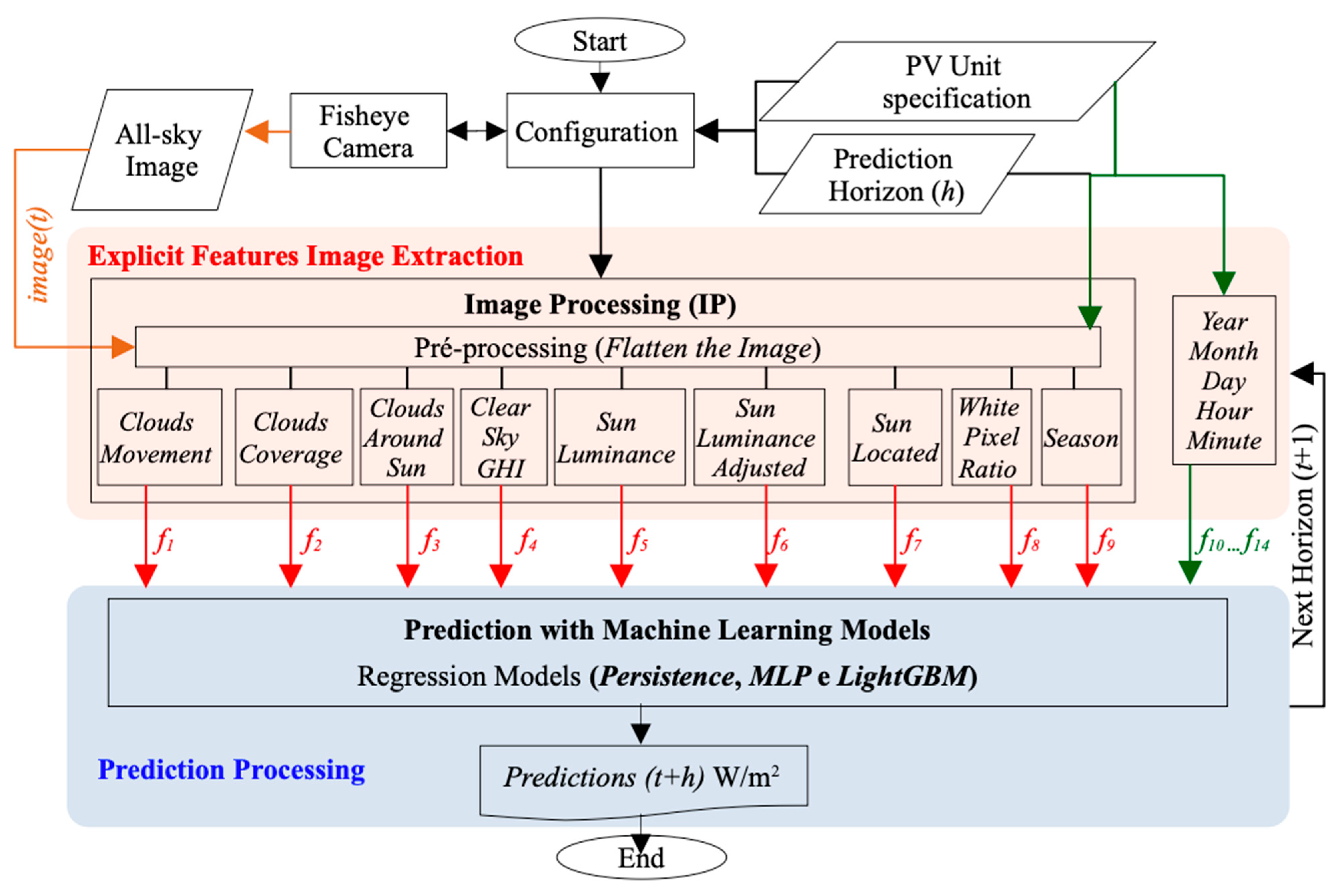
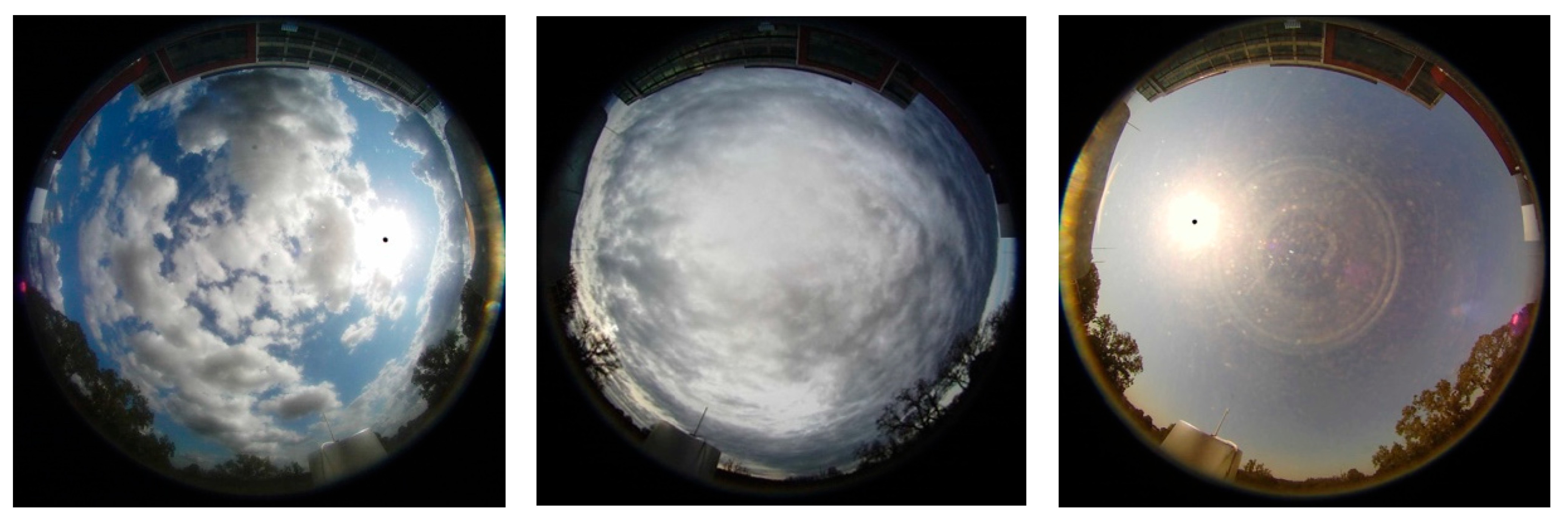
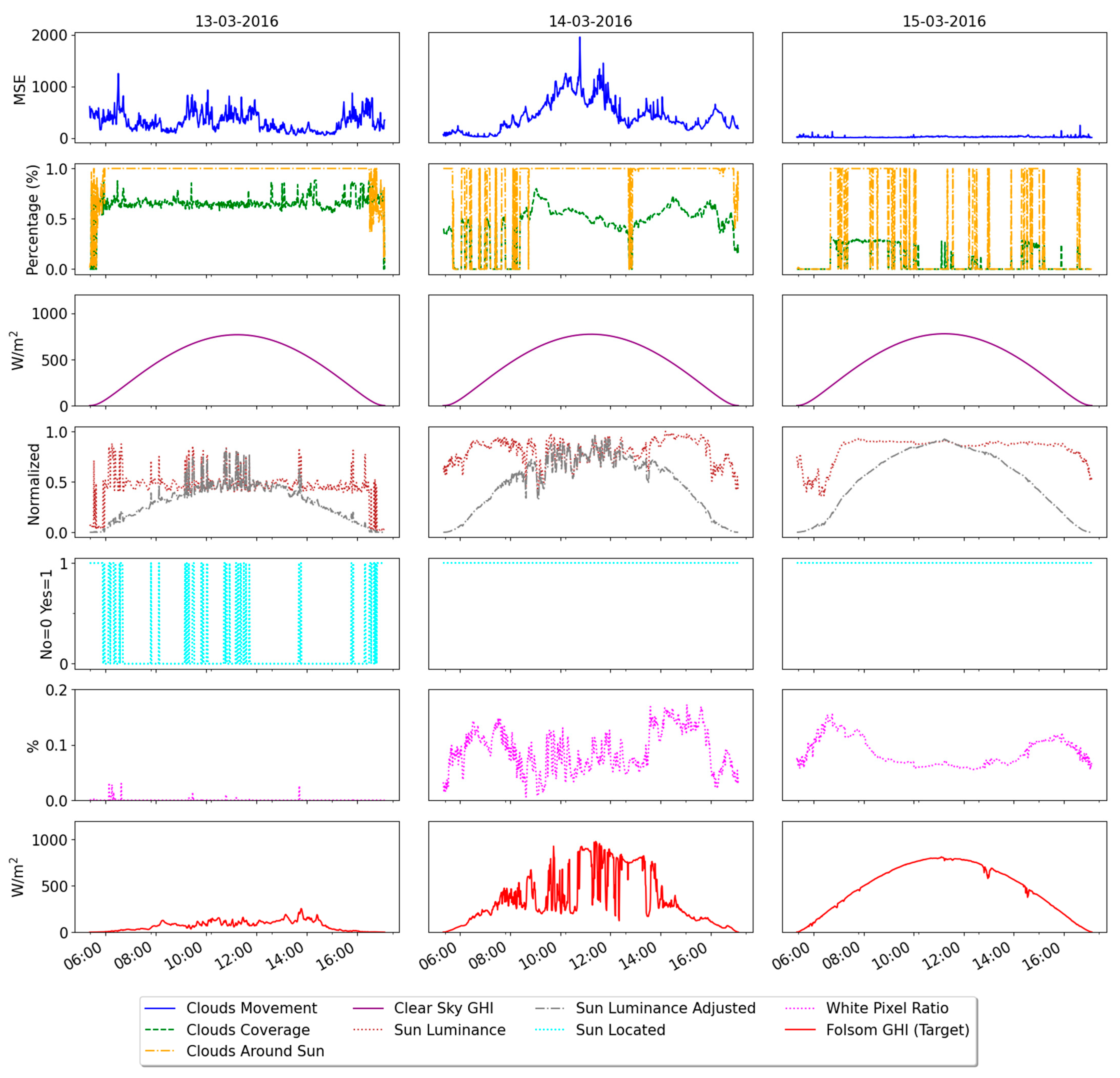
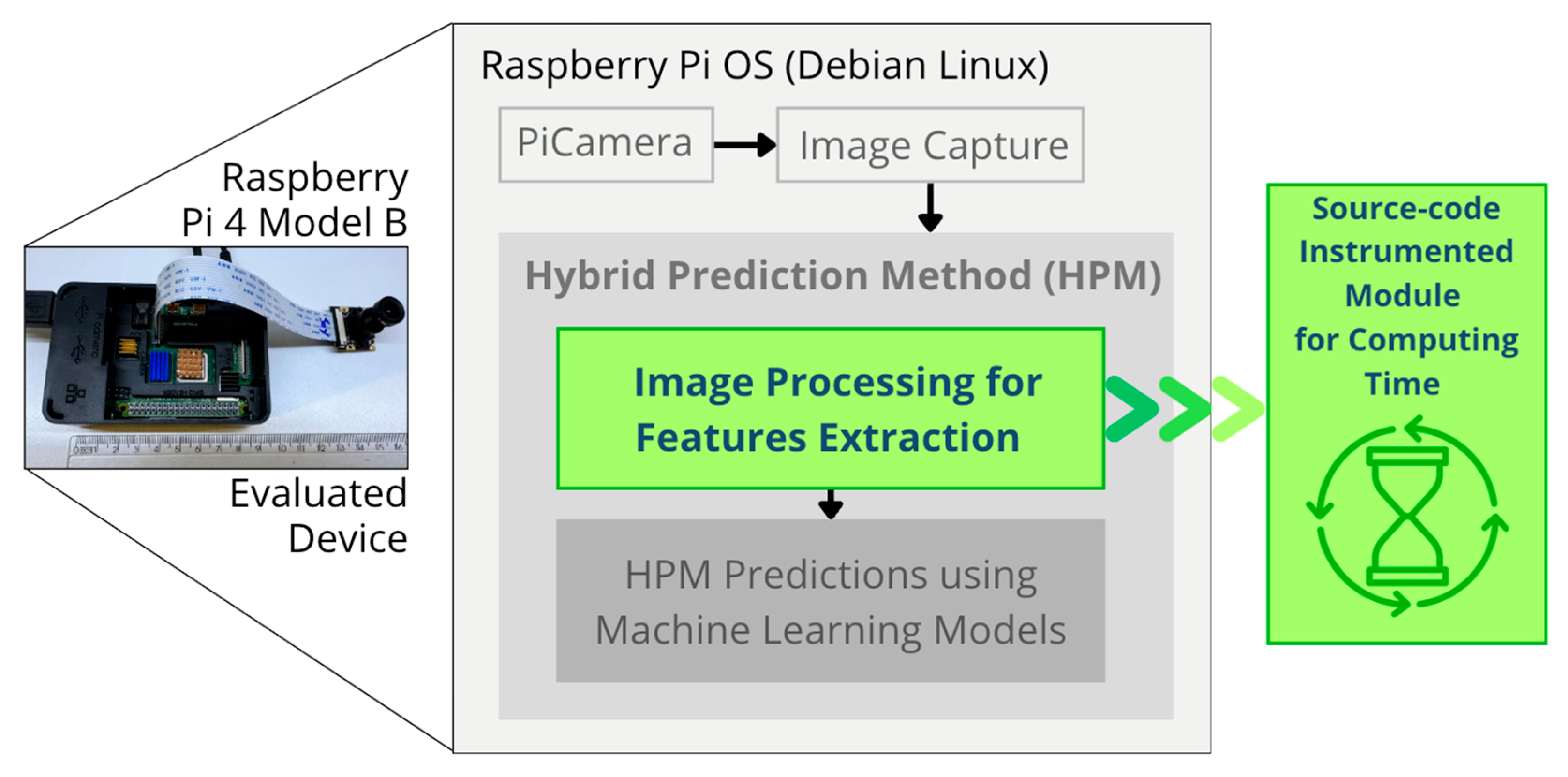
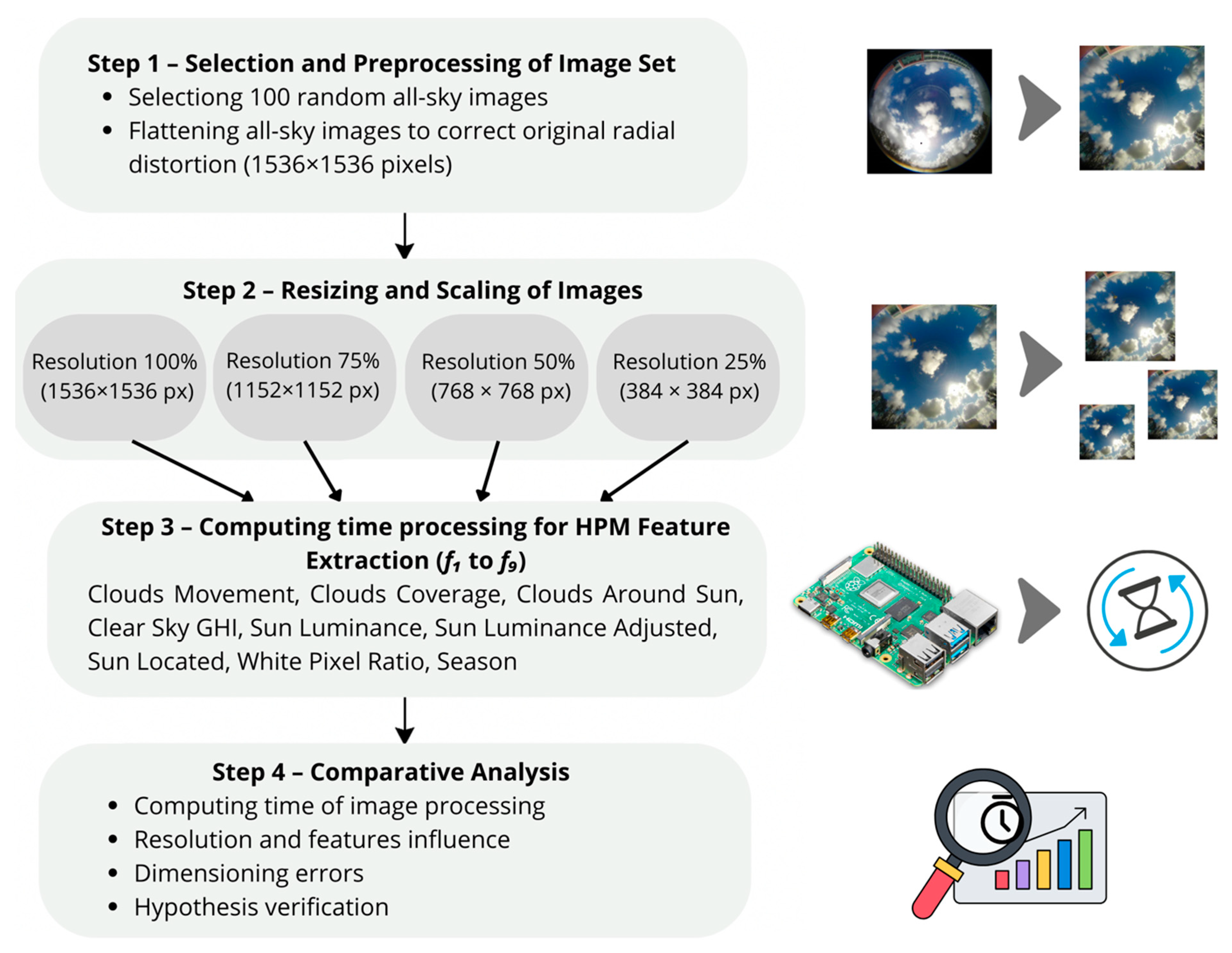
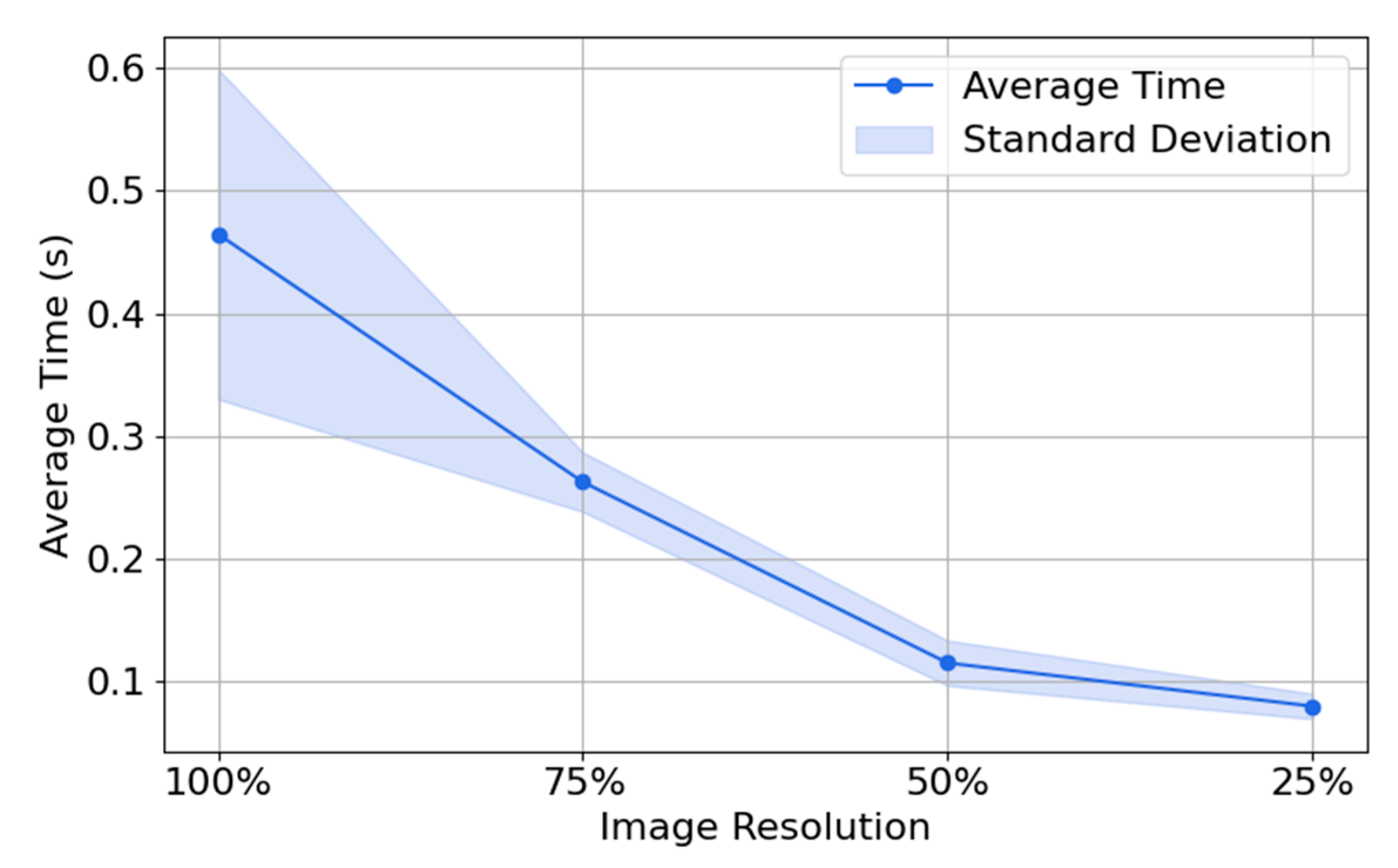
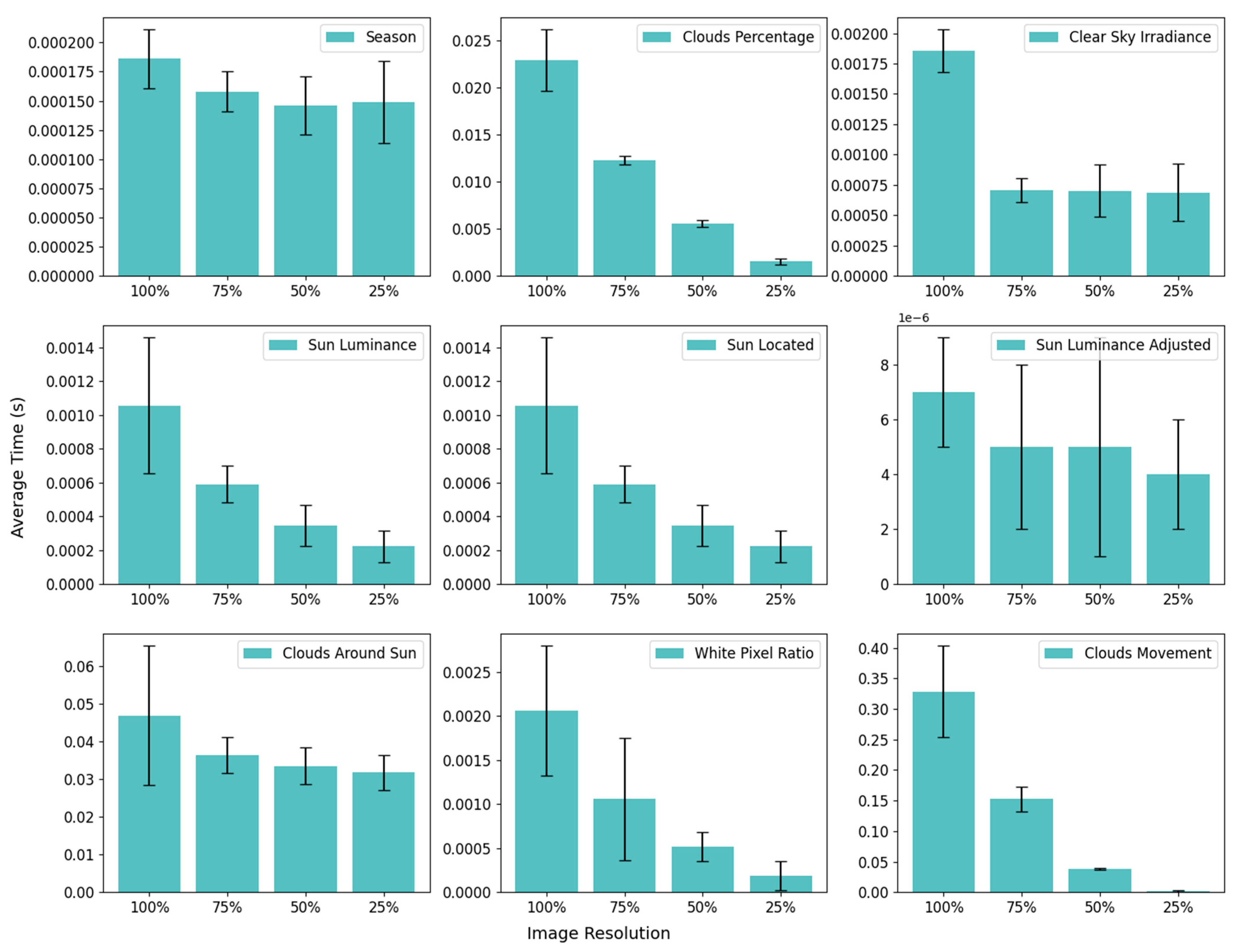
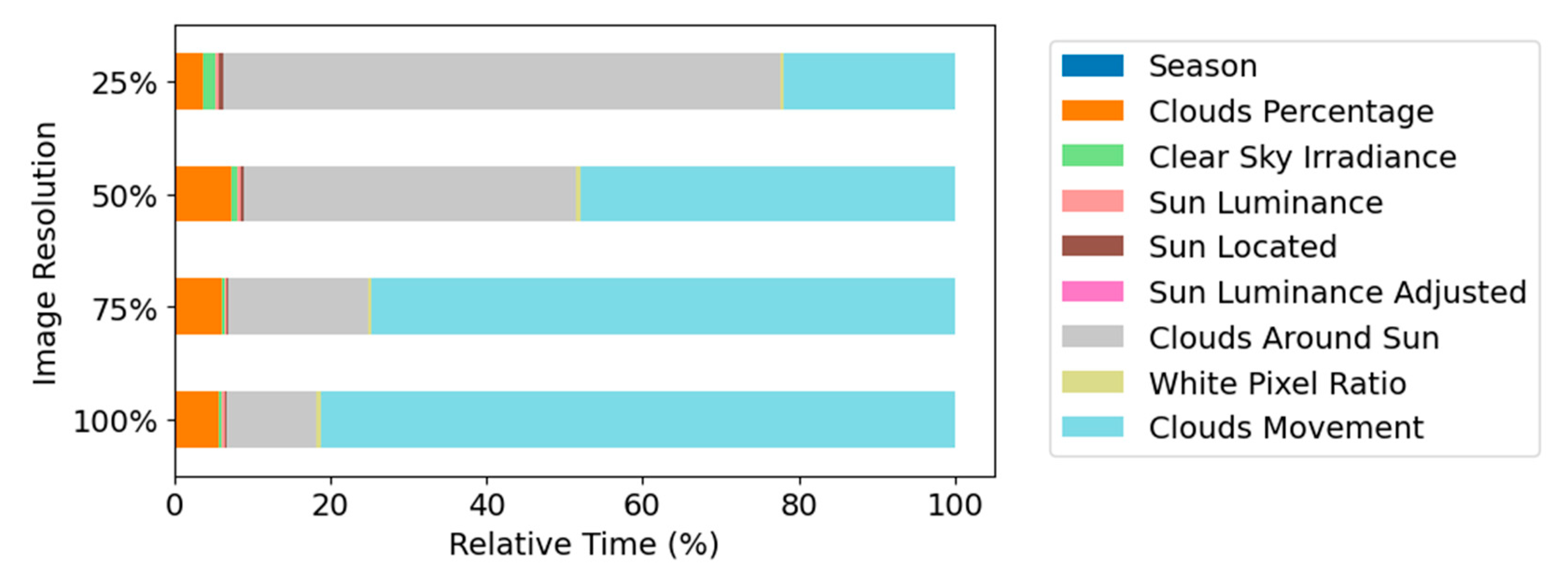
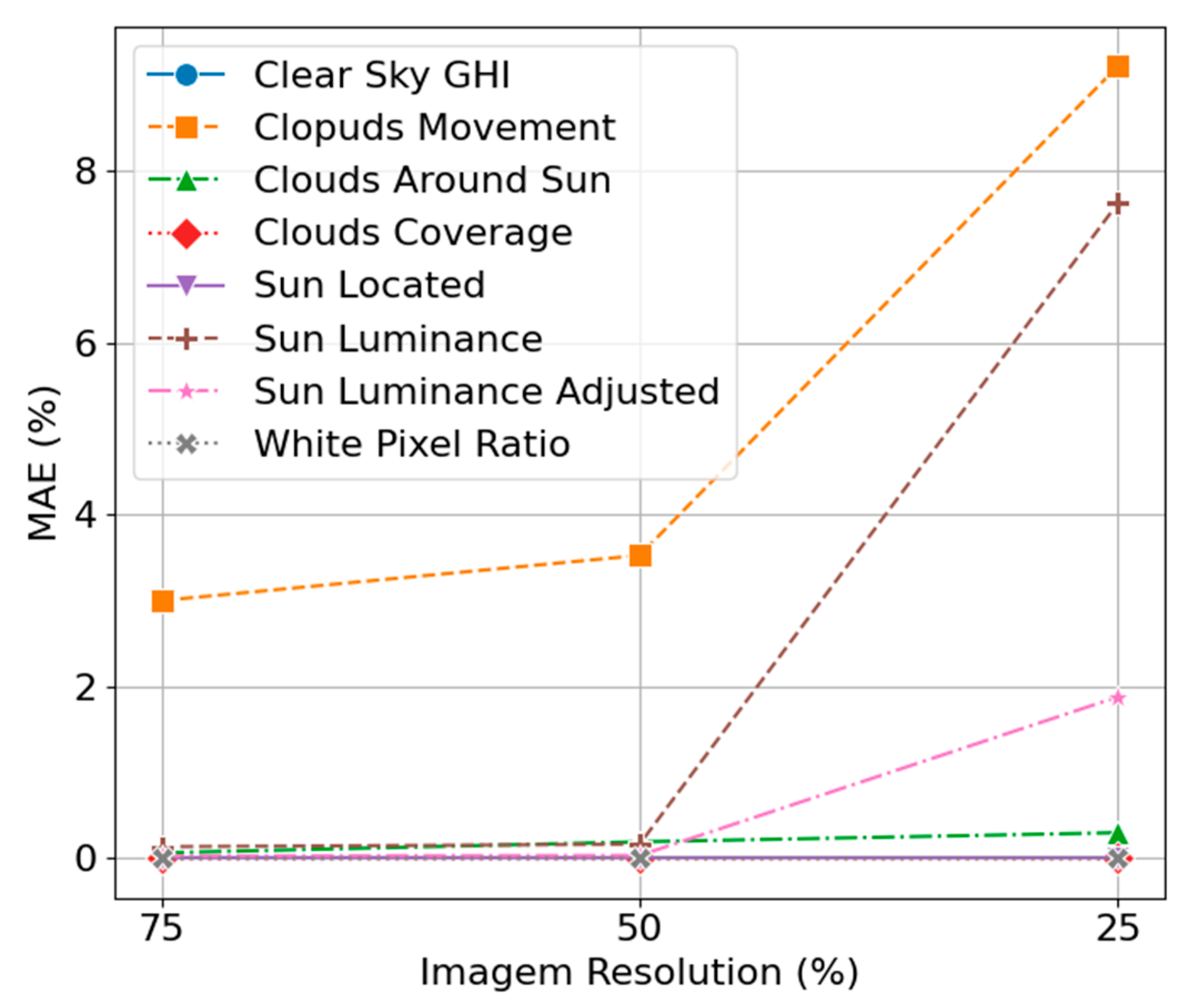
| Resolution (%) | Overall Time (s) | Average Time Per Image (s) | Standard Deviation (s) |
|---|---|---|---|
| 100 | 46.47 | 0.4647 | 0.1345 |
| 75 | 26.25 | 0.2624 | 0.0242 |
| 50 | 11.48 | 0.1148 | 0.0184 |
| 25 | 7.95 | 0.0795 | 0.0103 |
| Resolution | Season | Clouds Coverage | Clear Sky GHI | Sun Luminance | Sun Located | Sun Luminance Adjusted | Clouds Sun Around | White Pixel Ratio | Clouds Movement | |
|---|---|---|---|---|---|---|---|---|---|---|
| 100% | 0.000186 | 0.022886 | 0.001853 | 0.001056 | 0.001056 | 0.000007 | 0.046878 | 0.002059 | 0.328674 | |
| σ | 0.000025 | 0.003234 | 0.000176 | 0.000401 | 0.000401 | 0.000002 | 0.018405 | 0.000735 | 0.074285 | |
| 75% | 0.000158 | 0.012238 | 0.000708 | 0.000589 | 0.000589 | 0.000005 | 0.036446 | 0.001057 | 0.152672 | |
| σ | 0.000017 | 0.000461 | 0.000097 | 0.000109 | 0.000109 | 0.000003 | 0.004741 | 0.000692 | 0.020495 | |
| 50% | 0.000146 | 0.005546 | 0.000701 | 0.000345 | 0.000345 | 0.000005 | 0.033521 | 0.000515 | 0.037913 | |
| σ | 0.000025 | 0.000379 | 0.000215 | 0.000122 | 0.000122 | 0.000004 | 0.004795 | 0.000164 | 0.001190 | |
| 25% | 0.000149 | 0.001550 | 0.000687 | 0.000222 | 0.000222 | 0.000004 | 0.031729 | 0.000186 | 0.001910 | |
| σ | 0.000035 | 0.000319 | 0.000238 | 0.000093 | 0.000093 | 0.000002 | 0.004613 | 0.000163 | 0.000997 |
| HPM Computed Features | Resolution 100% | Resolution 75% | Resolution 50% | Resolution 25% |
|---|---|---|---|---|
| Clouds Movement | 32.867 | 15.267 | 3.791 | 0.997 |
| Clouds Around Sun | 4.688 | 3.645 | 3.352 | 3.236 |
| Clouds Coverage | 2.289 | 1.224 | 0.555 | 0.155 |
| White Pixel Ratio | 0.206 | 0.106 | 0.051 | 0.019 |
| Clear Sky GHI | 0.185 | 0.071 | 0.070 | 0.069 |
| Sun Luminance | 0.106 | 0.059 | 0.034 | 0.022 |
| Sun Located | 0.106 | 0.059 | 0.034 | 0.022 |
| Sun Luminance Adjusted | 0.001 | 0.001 | 0.0005 | 0.0005 |
| Season | 0.019 | 0.016 | 0.015 | 0.015 |
| HPM Features | Mean Absolute Error (MAE) | ||
|---|---|---|---|
| 75% | 50% | 25% | |
| Clouds Movement | 2.9979 | 3.5229 | 9.2122 |
| Clouds Coverage | 0.0003 | 0.0004 | 0.0005 |
| Clear Sky GHI | 0.0000 | 0.0000 | 0.0000 |
| Sun Luminance | 01340 | 0.1636 | 7.6157 |
| Sun Luminance Adjusted | 0.0258 | 0.0323 | 1.8763 |
| Sun Located | 0.0000 | 0.0000 | 0.0000 |
| Clouds Sun Around | 0.0628 | 0.1911 | 0.2971 |
| White Pixel Ratio | 0.0002 | 0.0001 | 0.0005 |
Disclaimer/Publisher’s Note: The statements, opinions and data contained in all publications are solely those of the individual author(s) and contributor(s) and not of MDPI and/or the editor(s). MDPI and/or the editor(s) disclaim responsibility for any injury to people or property resulting from any ideas, methods, instructions or products referred to in the content. |
© 2025 by the authors. Licensee MDPI, Basel, Switzerland. This article is an open access article distributed under the terms and conditions of the Creative Commons Attribution (CC BY) license (https://creativecommons.org/licenses/by/4.0/).
Share and Cite
Piovesan, D.; Maciel, J.N.; Zalewski, W.; Gimenez Ledesma, J.J.; Cavallari, M.R.; Ando Junior, O.H. Edge Computing: Performance Assessment in the Hybrid Prediction Method on a Low-Cost Raspberry Pi Platform. Eng 2025, 6, 255. https://doi.org/10.3390/eng6100255
Piovesan D, Maciel JN, Zalewski W, Gimenez Ledesma JJ, Cavallari MR, Ando Junior OH. Edge Computing: Performance Assessment in the Hybrid Prediction Method on a Low-Cost Raspberry Pi Platform. Eng. 2025; 6(10):255. https://doi.org/10.3390/eng6100255
Chicago/Turabian StylePiovesan, Dhyogo, Joylan Nunes Maciel, Willian Zalewski, Jorge Javier Gimenez Ledesma, Marco Roberto Cavallari, and Oswaldo Hideo Ando Junior. 2025. "Edge Computing: Performance Assessment in the Hybrid Prediction Method on a Low-Cost Raspberry Pi Platform" Eng 6, no. 10: 255. https://doi.org/10.3390/eng6100255
APA StylePiovesan, D., Maciel, J. N., Zalewski, W., Gimenez Ledesma, J. J., Cavallari, M. R., & Ando Junior, O. H. (2025). Edge Computing: Performance Assessment in the Hybrid Prediction Method on a Low-Cost Raspberry Pi Platform. Eng, 6(10), 255. https://doi.org/10.3390/eng6100255








